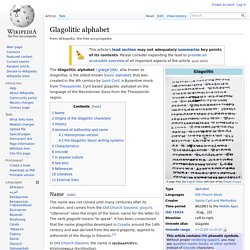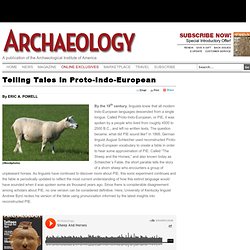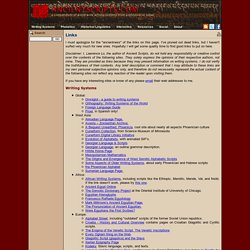

Pali Language Study Aids. Introduction to Pali, by A.K.

Warder London: Pali Text Society, 1963; rev. 1991. 464pp., with exercises. Available from Pariyatti. Companion audio CD also available. Known popularly as "Warder," this is the standard Pali textbook used today. The companion CD is well worth purchasing, as it gives the student a good idea of what "real" spoken Pali should sound like. Although each chapter contains numerous exercises or passages for reading and translation, the latest edition contains answers to only the first seven exercises.
Glagolitic alphabet. The Glagolitic alphabet /ˌɡlæɡɵˈlɪtɨk/, also known as Glagolitsa, is the oldest known Slavic alphabet, that was created in the 9th century by Saint Cyril, a Byzantine monk from Thessaloniki.

Cyril based glagolitic alphabet on the language of the Macedonian Slavs from the Thessaloniki region. Name[edit] The name was not coined until many centuries after its creation, and comes from the Old Church Slavonic glagolъ "utterance" (also the origin of the Slavic name for the letter G). The verb glagoliti means "to speak". Worldmapper: The world as you've never seen it before. This map uses data from 'Ethnologue: Languages of the World', and shows the number of languages considered indigenous to each country that are still spoken there.

Due to issues of language identification (see technical notes), it is possible to dispute the data used here, and a review of Ethnologue by Campbell and Grondona (2008) does just that; they claim "... the number of indigenous ('living') languages of different countries is inflated ... ". However, the map presents a good picture of linguistic diversity.
Papua New Guinea has nearly 10% (820) of the world's indigenous living languages, so that there are only an average of 7000 speakers per language living there. Lexicity. Living Languages. Living Languages. Textes latins et grecs. INUKTITUT. Futharken. Language Etymology. Lingua Franca. संस्कृतम् Every language evolved from 'single prehistoric mother tongue first spoken in Africa' By David Derbyshire Updated: 00:25 GMT, 17 April 2011 500 languages traced back to Stone Age dialectThe further away from Africa a language is spoken, the fewer distinct sounds it hasEnglish has around 46 sounds, while the San bushmen of South Africa use a staggering 200Study finds speech evolved 'at least 100,000 years ago' Every language in the world - from English to Mandarin - evolved from a prehistoric 'mother tongue' first spoken in Africa tens of thousands of years ago, a new study reveals.

After analysing more than 500 languages, Dr Quentin Atkinson found compelling evidence that they can be traced back to a long-forgotten dialect spoken by our Stone Age ancestors. The findings don't just pinpoint the origin of language to Africa - they also show that speech evolved at least 100,000 years ago, far earlier than previously thought. Indo-European Languages Originated in Anatolia, Biologists Say. The family includes English and most other European languages, as well as Persian, Hindi and many others.

Telling Tales in Proto-Indo-European. (iStockphoto) By the 19th century, linguists knew that all modern Indo-European languages descended from a single tongue.

Called Proto-Indo-European, or PIE, it was spoken by a people who lived from roughly 4500 to 2500 B.C., and left no written texts. The question became, what did PIE sound like? Symboldictionary.net. Runes. ELICITING SOUNDS /r/ Good Morning SLPs!

This will mark the final entry on our series Eliciting Sounds. We are going to talk about /r/ which has been labeled by many as the "hardest" sound to teach. There are many suggested techniques to try so keep in mine these two things: 1. go with the strategy that you are most comfortable and confident and 2. keep trying different strategies until you find one that works for the kid sitting in front of you.
Just because it worked with the last kid does not mean it will work with this one! Now with that in mind here are our tips. TIP #1 Visual Verbal Label I’ve heard the R sound labeled as many different and creative things. Magazine: Language. Evolution of Language Takes Unexpected Turn. It’s widely thought that human language evolved in universally similar ways, following trajectories common across place and culture, and possibly reflecting common linguistic structures in our brains.

But a massive, millennium-spanning analysis of humanity’s major language families suggests otherwise. Instead, language seems to have evolved along varied, complicated paths, guided less by neurological settings than cultural circumstance. If our minds do shape the evolution of language, it’s likely at levels deeper and more nuanced than many researchers anticipated. “It’s terribly important to understand human cognition, and how the human mind is put together,” said Michael Dunn, an evolutionary linguist at Germany’s Max Planck Institute and co-author of the new study, published April 14 in Nature. Links. I must apologize for the "ancientness" of the links on this page.

I've pruned out dead links, but I haven't surfed very much for new ones. Hopefully I will get some quality time to find good links to put on here. Disclaimer: I, Lawrence Lo, the author of Ancient Scripts, do not hold any responsibility or creative control over the contents of the following sites. They solely express the opinions of their respective authors, not mine. They are provided as links because they may present information on writing systems. If you have any interesting sites or know of any please email their web addresses to me. Writing Systems. Centre for the Study of Ancient Documents. Centre for the Study of Ancient Documents. India: Languages and Scripts. Bengali. Bengali is a Nagari-derived script that appeared in eastern South Asia around the 11th century CE.

It is still currently used in Bangladesh, as well as the state of West Bengal in India (hence the script's name) on the eastern part of India. The old Bengali script (11th century CE) is also the parent to many other scripts of eastern India, such as Oriya, Manipuri, and Maithili. The Bengali script is used to writer languages in eastern India such as Bengali, Assamese, and Manipuri. Once again, like other South Asian writing systems, vowels following a consonant other than the default /a/ is written with extra strokes, as in the following example: Related Links Languages and Scripts of India. Aramaic language. This article is about the Semitic language now spoken by smaller numbers of people in scattered locations.
For the Semitic language spoken in Ethiopia, see Amharic. Aramaic (Arāmāyā, Classical Syriac: ܐܪܡܝܐ) is a family of languages or dialects belonging to the Semitic family. More specifically, it is part of the Northwest Semitic subfamily, which also includes Canaanite languages such as Hebrew and Phoenician. The Aramaic script was widely adopted for other languages and is ancestral to both the Arabic and modern Hebrew alphabets. Akkadian language. The mutual influence between Sumerian and Akkadian had led scholars to describe the languages as a sprachbund.[3] Akkadian proper names were first attested in Sumerian texts from ca. the late 29th century BC.[4] From the second half of the third millennium BC (ca. 2500 BC), texts fully written in Akkadian begin to appear. Hundreds of thousands of texts and text fragments have been excavated to date, covering a vast textual tradition of mythological narrative, legal texts, scientific works, correspondence, political and military events, and many other examples.
By the second millennium BC, two variant forms of the language were in use in Assyria and Babylonia, known as Assyrian and Babylonian respectively. Akkadian had been for centuries the lingua franca in Mesopotamia and the Ancient Near East. Namaste - The Yogic Greeting - Exotic India Art. Unilingua-instantly. Unilingua; langue universelle auxiliaire. (Book, 1965) 22 Maps That Show The Deepest Linguistic Conflicts In America.
The Evolution of the English Alphabet Chart [In Progress] – Yehweh Not Yahweh. The Evolution of the English Alphabet Chart shows how over the last 4000 years the English alphabet along with at least 13 other major alphabets has evolved (or rather mutated) out of the Ancient Hebrew alphabet. Middle English Dictionary: Introduction. Veritas in Latin Middle Ages from Augustine to Paul of Venice.
"Almost everyone knows that it was Aristotle who proposed the classical (or correspondence) theory of truth for the first time. Latin proverbs and locutions. Fun latin. Latin phrases. It’s a matter of taste and style, but not long ago American writers attempted to demonstrate their credentials to the world by including Latin and French phrases within works.
English-Latin translator : One Click Search - (c) 2000-2009 Stars21.com. Latin online. List of Germanic and Latinate equivalents in English. Latin Phrases. Englishman's Greek Concordance. Greek and latin. Aryan Language Family. How to raise a language from the dead. Chaucer wrote the Canterbury Tales in Middle English, not Old English. Iif it had been written in Old English, it would be almost unreadable to the average student: Ancient Language Computer Program Recreates Sound Of Dead Tongues, Scientists Say. HISTORY OF LANGUAGE. Clues to Lost Prehistoric Code Discovered in Mesopotamia.
Did Stone Age cavemen talk to each other in symbols? Simulated Linguistic Evolution In The Laboratory. About a week ago, I read and posted on a summary piece on cultural evolution research in PLoS Biology. The reviewer introduced me to Simon Kirby‘s work, which I found remarkable. Kirby and colleagues setup an experiment, one that observed the evolution of an artificial language from a set of random terms to an ordered, naturally adapting system in ways that assured its reproduction.
I didn’t know when Kirby was to publish his work, but lo and behold in this week’s issue of PNAS, I saw “Cumulative cultural evolution in the laboratory: An experimental approach to the origins of structure in human language,” by Simon Kirby, Hannah Cornish, and Kenny Smith. The experiment involved showing subjects illustrations that were associated with nonsense words. Faculty of language evolution Hauser-2002-faculty.pdf. Ancient history. Linguistic Evolution. Language Learning.